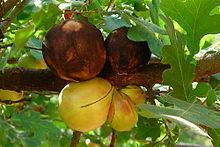Family Cynipidae Rank Species | ||
 | ||
Similar Andricus, Andricus dentimitratus, Cynipini, Quercus lobata, Quercus berberidifolia | ||
Andricus quercuscalifornicus (occasionally. A. californicus), or the California Gall Wasp, is a small wasp species that induces oak apple galls on white oaks, primarily the Valley Oak (Quercus lobata) but also other species such as Quercus berberidifolia. It is found from Washington, Oregon, and California to northern regions of Mexico. Often multiple wasps in different life stages occupy the same gall.
Contents
Description
The adult wasps are small, stout and brown, about 5mm long with clear wings nearly twice the length of the body. The antennae are filiform and about the same length as the legs. Despite their size they are one of the largest species of Cynipid wasps.
The gall itself is a typical oak apple gall in appearance, roughly spherical and varies from greenish to reddish or orange depending on host, age and environmental conditions. The galls range in size from a 2-14 centimeters across and often contain multiple larvae as well as parasites and other species that form a mutual relationship by feeding off the galls themselves. The outer galls are hard in texture and are not easy to penetrate.
Life Cycle
A. quercuscalifornicus is believed to reproduce strictly by parthenogenesis, and no male specimens have ever been recovered. The adult female lays eggs in the cambium layer of Q. lobata twigs during the fall. More vigorous twigs will have more galls. The eggs overwinter on the twig, and then hatch in the spring, usually in early April. The resulting larvae induce galls immediately, where they can seem to balloon almost overnight onto the tree. This is the point where most of the parasitoids enter the gall, while it is still soft and small enough for their ovipositor to reach the larvae. After a few weeks, the gall stops growing and begins to desiccate, turning tan or brown. The larvae pupate and then bore their way out of the gall in late summer or early fall. They then fly off to lay eggs in other trees. A few larvae overwinter inside the gall and don't emerge until the following fall. The reason for this is unknown.
These wasps form an important role in the ecosystem, with more than 20 known species that are parasitoids, inquilines, and hyperparasites that live on its life cycle, while the galls form a persistent shelter for various forms of fungi as well as many other insects. Several birds are also known to feed from the galls and their inhabitants.
